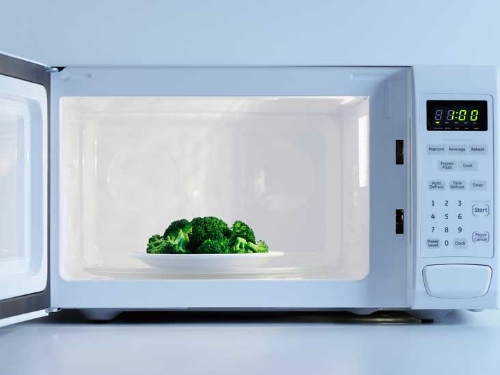While your microwave is excellent for reheating that day-old cup of coffee, should it be used to kill germs, including flu viruses, dangerous bacteria, and even coronaviruses? It is a known fact that high heat can destroy bad pathogens, but can it destroy bacteria and viruses that travel into your home via your favorite take out food? Let’s take a closer look at just what a microwave can do and what you should not use this high-heat zapping machine for.
BREAKING: 1 Cup of This Melts Belly and Arm Fat (Take Before Bed)
Killing germs in a microwave
In 2007, researchers from the University of Florida wanted to know if using a microwave could kill bacteria on a sponge. To conduct the experiment, researchers drenched sponges and kitchen scrubbers in a gross cocktail containing everything from raw wastewater laced with fecal bacteria to viruses and parasites. They even included Bacillus cereus spores, that are known to be extremely hard to kill with heat, chemicals, and even radiation
When sponges and kitchen scrubbers were zapped for two minutes on high power, 99 percent of all living pathogens were deactivated. For the B. cereus spores, it took four minutes at high heat for the deactivation to occur. Study leaders said this,
“People often put their sponges and scrubbers in the dishwasher, but if they really want to decontaminate them and not just clean them, they should use the microwave.”
How do microwaves kill germs?
Although it may seem that microwaves would kill by radiation, it is actually the heat that does the pathogens in. When you cook food conventionally by baking or frying as well as microwaving, bacteria and viruses in foods are destroyed as long as all parts of the food are brought to a proper temperature. Here are some temperature suggestions:
- According to the CDC, influenza, flu, and virus are killed at heat higher than 167 degrees F.
- According to the World Health Organization, avian influenza and viruses are killed at 158 degrees F.
- A coronavirus expert, Professor Stanley Perlman, says that cooking meat to 150 degrees F will make any coronavirus in meat inactive.
- Texas A&M University states that a temperature of 140 degrees F will kill most bacteria. However, Salmonella and others like it may need increased heat.
Remember, microwaves do not disinfect evenly
It is important to keep in mind that microwaves do not heat or disinfect evenly. If you use your microwave for reheating, you will know this to be true. Some parts of your dinner may be hot, some warm, and some even still cold. The same holds true if you use your microwave as a disinfecting tool. Some bacteria may remain active unless due diligence is taken to ensure all parts have been evenly zapped.
Sterilizing medical devices in the microwave is not approved by the FDA
A 2019 report by the CDC states that using a microwave to sterilize medical devices is not approved by the Food and Drug Administration (FDA). Among these devices are thermometers and medical masks.
Disposable medical masks are not made to be used more than once; they are like tissues in that they are meant to be thrown away after each use. According to Hsy Li Yang, a program leader for infectious diseases at the HUS Saw Swee Hock School of Public Health, you should not try to sanitize masks in the microwave. This can damage the masks and render them ineffective.
Sterilizing using water and a microwave
Some studies show that microwave sanitation using water is effective. Because of this, the CDC recommends steaming some items as a method of sanitation. Specifically, they suggest this as a method to sterilize baby feeding supplies after they have been thoroughly cleaned with soap and water. In addition, this same method, according to the CDC, is appropriate for medical syringes, medicine cups, and medicine spoons.
Follow this method for sterilizing using water and a microwave:
- Wash all items thoroughly with soap and water.
- Disassemble items if you can and place them in a microwave steaming system. If you do not have one, place items in a glass or ceramic container with a lid.
- Cook the items on high for four to six minutes. The CDC states that most bacteria are dead after six minutes.
- Completely air dry materials before you use them again or put them into storage.
Killing germs in food using a microwave
Let’s get back to that order of your favorite black bean soup from the local deli or even that pizza with the best sauce ever. Does putting takeout food in the microwave deactivate germs, including viruses and bacteria, that may have hitchhiked their way onto your dinner? While there is no guarantee that this method will knock out all germs, here is something that you can try.
- Carefully wipe down all takeout containers using a soft cloth dampened with water and soap.
- Place your food into a sterilized microwave-safe container with a lid.
- Check the internal temperature of the food in several spots to ensure even heating. It should be at least 170 degrees F.
TRENDING: Big Pharma In Outrage Over This Breakthrough Natural Painkiller
Things you should definitely not put in the microwave
Microwaves are made to heat food and beverages. With that said, there are certainly things that should not be put into the microwave because they could cause a fire or a small explosion, including.
- Metal objects of any kind
- Eggs in the shell
- Lightweight plastics including plastic bags
- Foam insulated containers
- Styrofoam
- Paper or paper bag
Bottom line
Heat is an enemy to germs, including bacteria and viruses. However, to use your microwave for anything other than its intended purpose requires research and caution.









